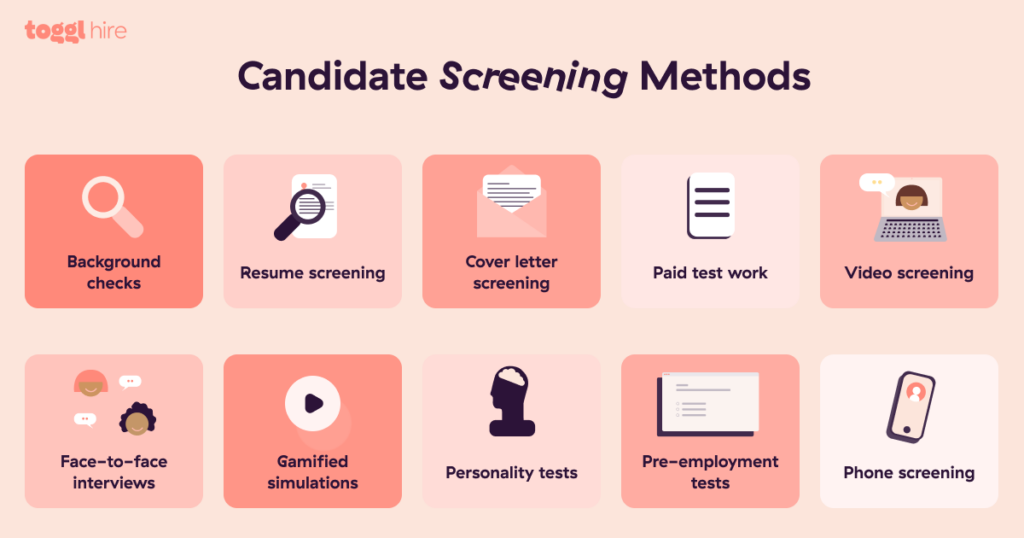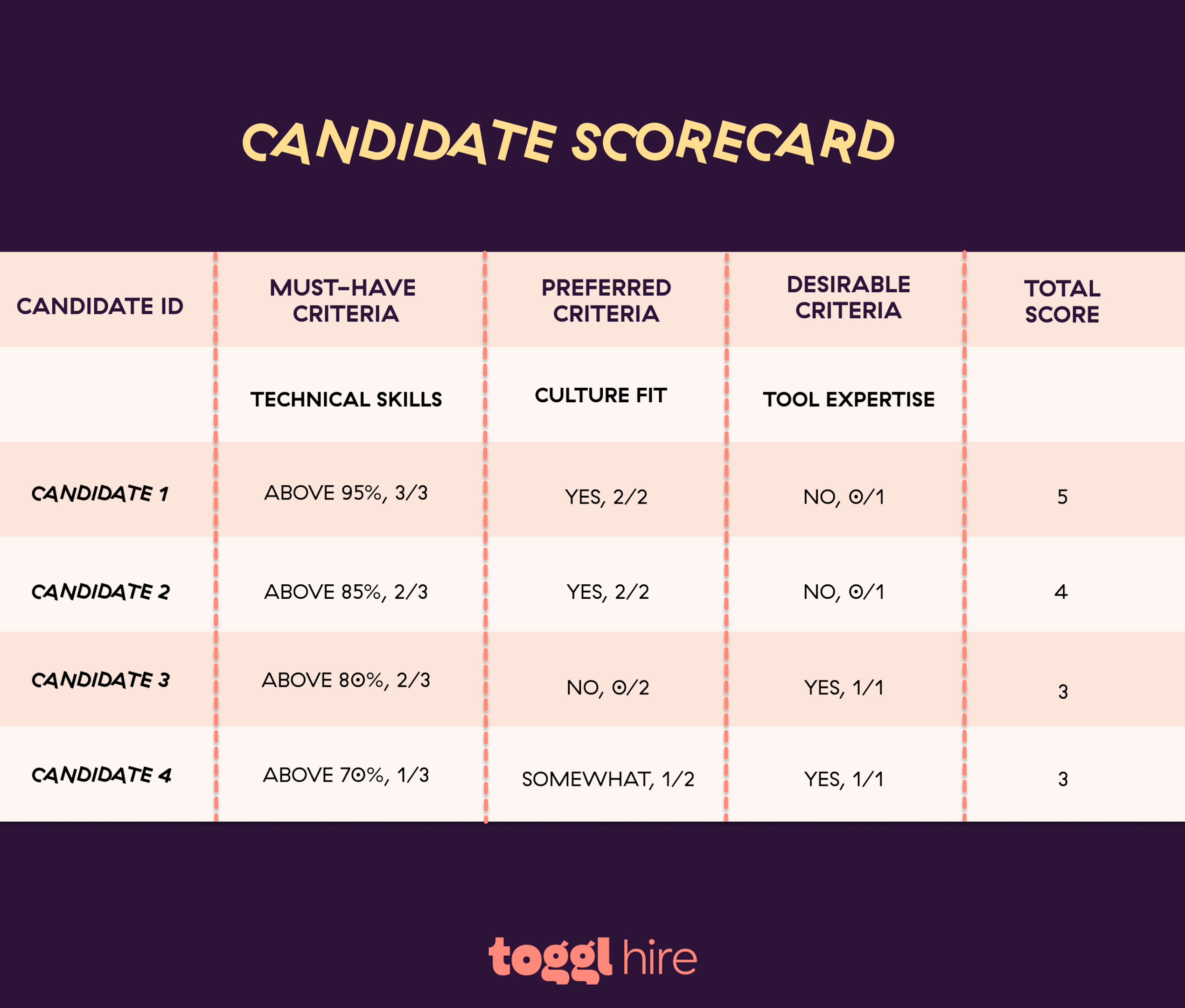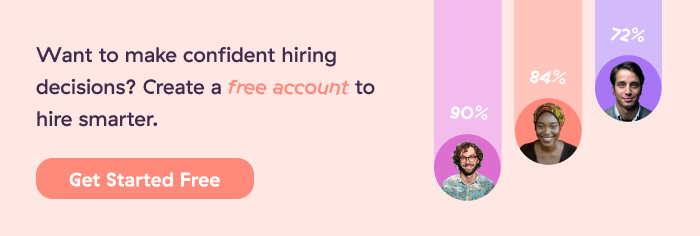Shortlisting candidates is one of the toughest yet most beneficial parts of the hiring process. Get candidate shortlisting right, and you’ll be well on your way to hiring a superstar. Get it wrong, and you won’t just waste time and effort, but you’ll increase your risk of a bad hire.
But just how do you ‘get it right?’ It all starts by understanding what candidate shortlisting is and why it’s so important as part of an efficient, bias-free hiring funnel. Then, it helps to understand what good shortlisting techniques look like and which tools are available to help you make the process simple, structured, and risk-free.
TL;DR — Key Takeaways
- Candidate shortlisting is the process of selecting the most qualified applicants from a pool for further recruitment stages.
- A structured candidate shortlisting process ensures fairness, boosts efficiency, and increases the chances of finding the best fit for a role.
- A great shortlisting process is systematic, transparent, and objective, involving multiple rounds of screening based on clear job requirements.
- Using shortlisting tools can be a great way to automate parts of the process, reduce manual work, and provide more accurate matches through AI and machine learning.
- To correctly and effectively implement shortlisting practices, it helps to define the job requirements, choose a fitting tool, and regularly review and adjust the process for optimal results.

What is candidate shortlisting?
Candidate shortlisting is the process of reducing a large volume of candidates down to a small list to move forward in the hiring process.
Shortlisting comes after the sourcing phase (typically a job advert/social media campaign) and is part of the wider screening process, where all your applicants are evaluated and filtered down to a select few.
To do this, recruiters assess the applicant pool against shortlist criteria. This is essentially a list of skills, knowledge, competencies, or experiences that a candidate needs to have to do the job. As a candidate, you’ll make the list of shortlisted applicants if you meet all/most of the criteria. If you don’t, you’ll be rejected for the role.
But it isn’t always that cut and dry. Shortlist criteria are often broken down into essential and desirable criteria to give recruiters some flexibility when hiring the right person. As we’ll see later on, the way businesses complete their shortlisting process is very different. Some of the variables include:
- How companies shortlist: Technology vs. manual
- What they shortlist based on: Skills vs. experience vs. personality
- When they shortlist: Straight after sourcing or later on
But one thing they all have in common is structure. However or whenever you decide to do your shortlisting, it needs to follow a consistent process.
Why it’s important to have a structured screening and shortlisting process
Having a structured approach to shortlisting sounds like common sense, right?
Maybe, but you’d be surprised by how many companies don’t have a consistent way to create a shortlist, assess qualified candidates against a set of criteria (not opinions), and move forward the right candidates to the interview stage.
If that’s you (no judgment!), here are some of the key benefits you’re missing out on.
1. Speeds up the recruitment process
Having a structured, streamlined approach to shortlisting helps your recruitment process go much, much faster — something that’s incredibly important in today’s hiring landscape, where the average time to hire sits at roughly 44 days.
When using the right candidate shortlisting process (and tools), it’s easy for recruiters to pull up a checklist of criteria, score candidates against that checklist, and then move on to the next one.
It’s not just a benefit for the candidate experience, either. When over half (52%) of talent acquisition professionals say screening candidates is the hardest part of recruitment, it just makes sense to make it faster.
2. Choose better candidates (and reduce the risk of a bad hire)
After speed comes quality. Having a consistent shortlisting process will help you better spot top talent within your applicant pool and decide who’s moving forward. That improves your hiring success rate and reduces the risk of a bad hire.
3. Waste less time on bad interviews
As a recruiter, your biggest time investment is likely supporting the hiring manager with interviews. That’s especially frustrating when the candidate shouldn’t have been there in the first place.
A consistent approach helps weed out poor candidates and leaves you with the best applicants for the rest of the recruitment process. The cool thing about that is that hitting your primary recruitment KPIs becomes that much easier when every hiring pipeline stage is optimized for the best performance.
4. Improve the candidate experience
The benefits aren’t just one-sided, as a consistent approach to shortlisting creates a smooth, seamless experience for candidates, too. That means whatever the outcome of the interview or initial screening process, candidates walk away impressed with the efficiency and professionalism of your organization.
5. Align your hiring team and establish fair hiring standards
Lastly, consistency is great for the working model and internal processes of your team. Not only does everyone know exactly how things should be done, but following the same shortlisting criteria and workflows also establishes a good standard of operation and keeps everyone honest and transparent.
Shortlisting criteria examples and best practices
So, now that you know why shortlisting is essential, it’s time to see how it’s done. If you’re building a process to shortlist candidates, here are some things to consider to make it a great one.
1. Have strict criteria and stick to them
When screening, it’s essential to have a robust set of shortlisting criteria. These will cover several things, but skills, abilities, and experience are some of the main ones.
That’s also why writing a strong, tailored job description that clearly outlines key requirements is crucial, or you’ll end up with a high volume of irrelevant applications.
Once the criteria are established, the key is to stick to them, regardless of the number of candidates in your pool or how many candidates you want to progress.
2. Select your screening method
There are many ways to go about screening and shortlisting. Traditionally, recruiters would sift through CVs and manually tick off the relevant essential criteria until they reached the bottom of the pile.
That’s pretty time-intensive. So nowadays, recruiters use technology to make the process slick, utilizing ATS systems, skills tests, or pre-recorded video async interviews. Think about what candidates want and design a screening and shortlisting process around those preferences.

3. Decide on how big your shortlist will be
Next, think about how many candidates you want to move forward through the rest of your process. This will largely depend on the role and the number of applicants, but the best practice is to shortlist 10-20 candidates.
The goal when choosing the number of candidates to shortlist is to keep the shortlist small enough to be manageable for your hiring managers but large enough to give them enough great candidates to interview and assess.
4. Decide on how you’ll score candidates
You’ll need a way to score candidates against the shortlist criteria to create that consistency. Most people do this on a points-based system, also known as a candidate scorecard.
If a candidate fully meets the criteria, they score one point. If they partially meet it, they score half a point. Add points together, and the top scorers make up the shortlist.
You don’t have to build a candidate interview scorecard from scratch either. Download our FREE scorecard template for interviews.

5. Remember to create a great candidate experience.
Never forget how hard candidates work to apply for jobs. They likely didn’t just apply to your job, either, which means they’re working hard to fill out applications, send in homework assignments, and attend interviews, all while dealing with the potential emotional effects of rejection.
So take some time to consider their needs. Shortlisted candidates should have a smooth experience when progressing to the next stage, and rejected candidates should be let down gently.
Put yourself in the candidate’s shoes and consider how you’d like to be treated. Create a shortlisting process that’s fast, full of feedback, and engaging.

3 tools to help you with candidate shortlisting
If you’re looking to level up the way you shortlist candidates, then you need to leverage the power of recruitment tools. Luckily, there are loads of great systems out there to help you separate qualified candidates from the rest. Here are a few of our favorites.
#1. Use skills assessments to screen and shortlist candidates
When shortlisting candidates, there aren’t many better ways to improve your hiring process than to adopt skills testing. Not only are skills assessment tools a great way to automatically shortlist candidates, but they’re also fun and engaging for candidates.
At Toggl Hire, for example, all it takes are two clicks to create tests for roles from software development to HR, with hundreds of questions to choose from, all created by industry experts. From there, invite as many candidates as you like to take the test. Once candidates start applying, our analytics dashboard makes applicant tracking easy, with a clear view of who scored best and who to take forward.
If you like the sound of that, see how we do it below with our Hiring Pipeline.
#2. Tap into specialized learning programs to find great candidates
If you want to help your candidates through the shortlisting process, BitDegree’s training-led screening could be for you.
Their innovative approach to the hiring process means you educate candidates to a point where they have the skills you need. This makes shortlisting candidates easier as you actually teach the candidates the knowledge they’ll need to meet your desired criteria.
Because of this, the engagement approach is different, too. Here, traditional job descriptions are swapped out for a marketing campaign that targets passive candidates.
#3. Use AI to shortlist candidates in a scientific way
If you want a way to revolutionize your talent acquisition pipeline, then Plum.io could be a great option for you.
Based on AI algorithms, Plum helps you identify the personality, problem-solving, and social intelligence traits required for any role. Through their data-driven tests, the tool helps you shortlist and move forward with the best-fit candidates.
The platform also has several anti-cheating measures, helping you remove bias against protected characteristics, basing decisions solely on ability. That means no more wasting time with people you don’t really want to interview.
Use smart shortlisting to hire better candidates
If you’re looking for ways to hire better candidates and improve your hiring process, optimizing your candidate shortlisting process is a great first step.
But with so many applicants and so little time, shortlisting accurately and consistently is a difficult task for many hiring teams. That’s why the best companies turn to tools like Toggl Hire. They use skills tests to screen candidates on their actual knowledge and abilities to create a shortlist of high-quality talent.
If you want to speed up your recruitment process while improving the quality of your candidates, check out Toggl Hire right now by signing up for your free account.

Elizabeth is an experienced entrepreneur, writer, and content marketer. She has nine years of experience helping grow businesses, including two of her own, and shares Toggl's mission of challenging traditional beliefs about what building a successful business looks like.




